NOTE: “Venom: Let There Be Carnage” is currently available to view in theatres here in North America, and elsewhere in the world wherever theatres are permitted to be open. When possible, we recommend that anyone without a full COVID-19 vaccination watch movies at home for the duration of the ongoing COVID-19 pandemic, for the safety of yourself and others. In the event that you do attend a movie theatre over the course of the ongoing COVID-19 pandemic however, please consult and follow public health guidelines in your region, and do not attend movie theatres if you feel unwell, or have been potentially exposed to COVID-19 through a known positive case.
FOR REFERENCE: This review of, “Venom: Let There Be Carnage” is based on a theatrical viewing.
2018’s Venom stands as one of the most interesting anomalies to come out of the modern superhero movie market. Simultaneously designed to launch a standalone Venom movie franchise for Sony Pictures, as well as yet another separate Spider-Man-themed cinematic universe that exists independently of Marvel’s flagship MCU, Venom ended up being blasted by critics, who hated its dopey characterization and half-baked storytelling, though it nonetheless garnered something of a cult following among Marvel fans. Much of this was due to lead star, Tom Hardy’s very well-received dual performance as Venom himself, as well as his reluctant human host, Eddie Brock. General moviegoing audiences at least initially responded to Hardy’s take on the character as well, considering that Venom quickly defied its negative critical reviews and mixed moviegoer feedback, ultimately eating its way to a hugely impressive $856 million box office haul worldwide, a total that both of Sony’s previous Amazing Spider-Man movies failed to reach.
Needless to say, that was more than enough to launch Sony’s much-coveted Venom franchise, as well as establish a foundation for Sony’s competing ‘Sony’s Spider-Man Universe’, the studio’s latest attempt to exploit their enduring hold on Marvel’s Spider-Man movie license. But how does this new cinematic franchise follow an openly ridiculous superhero B-movie progenitor that became a huge commercial success seemingly by accident? Well, it drops all pretense, and gives the people what they want, embracing critics’ hatred of it with a gonzo commitment to over-the-top action and intentionally goofy character writing. It also delivers by far the most popular of Venom’s established enemies in the antagonist role, and unleashes this mad cinematic science as a slick, 90-minute ode to 90’s-era anti-hero excess. This, my friends, is Venom: Let There Be Carnage, and it is as glorious as its subtitle suggests!
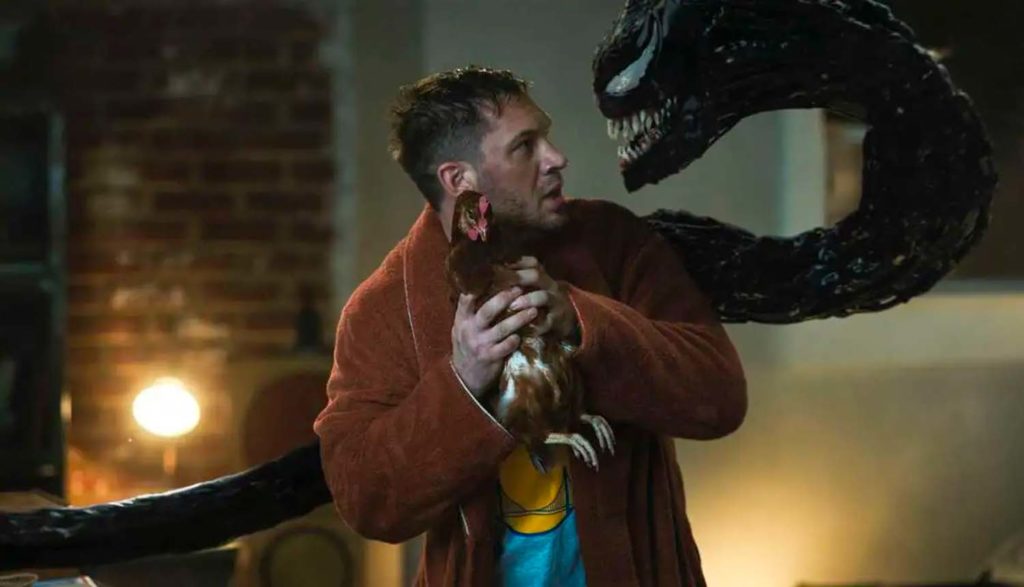
Okay, allow me to clarify; Venom: Let There Be Carnage is still not a conventionally ‘good’ superhero movie. It’s absurd, ill-plotted and almost proudly devoid of depth, and that’s just what’s immediately apparent to your eyes and brain. As silly as the MCU can be at times (by design), Venom: Let There Be Carnage almost makes the MCU feel pretentious by comparison. This sequel exists almost as a cheeky rebuttal to the kind of superhero movie conceit, and positively neurotic attention to detail that the MCU, and the competing DC Extended Universe for that matter, have begun to display since they took off. In that respect, Venom: Let There Be Carnage, dumb as it is, is actually a hell of a great time at the movies. It’s not only more entertaining and memorable than its 2018 predecessor, but also serves as an especially well-positioned, affectionately undemanding blockbuster to ease the mental distress and fatigue from so much COVID-19-related misery.
A bizarre, but no less noteworthy accomplishment from the first Venom movie is that it got almost every lead character wrong, but otherwise nailed how a live-action Eddie Brock/Venom combo should be portrayed in a PG-13 setting, without any connection to Spider-Man. This dynamic is once again placed front and center in Venom: Let There Be Carnage, a sequel that yet again plays up Eddie’s and Venom’s Odd Couple-style chemistry at the expense of almost every other personality. In fact, two of the only returning characters from the first movie are Michelle Williams’ Anne Weying, Eddie’s former fiancee, and Anne’s new fiance, Reid Scott’s Dr. Dan Lewis, both characters that continue to serve as little more than plot devices and joke fodder. It leads one to wonder why this sequel even bothered to bring them back, beyond another amusingly uncomfortable She-Venom gag with Williams anyway. Oh, and convenience store owner, Mrs. Chen is back I suppose, for more amusingly uncomfortable humour that works better than it has any right to.
One can’t fault Venom: Let There Be Carnage for also wanting to look forward with a mostly new cast though. The movie shifts away from the Life Foundation as a result, and instead brings in a whole new batch of fan-favourite characters from Venom’s comic book history. This includes detective character, Patrick Mulligan, played by Stephen Graham, who provides another welcome dimension to Eddie’s futile efforts to keep Venom under control. Mulligan’s presence is also a consequence to Eddie’s revitalized career as a journalist for the Daily Bugle (I guess this New York paper is also quite popular in San Francisco within this universe), which puts Mulligan on Eddie’s path after Eddie writes a groundbreaking story on soon-to-be-executed serial killer, Cletus Kasady.
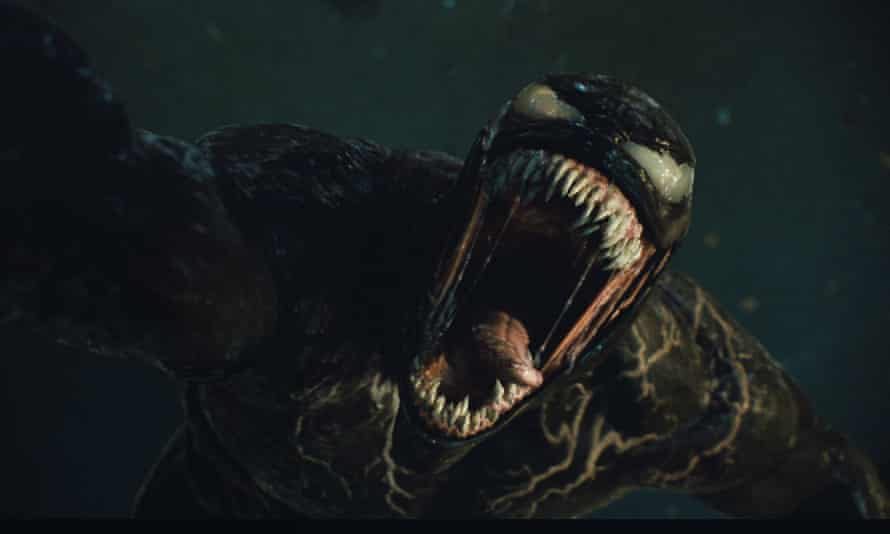
Kasady, again played by Woody Harrelson in this sequel, following the first Venom teasing Harrelson in the role during its post-credits scene, serves as the eponymous villain of Venom: Let There Be Carnage, eventually becoming host to Venom’s ‘spawn’, the unstable and bloodthirsty Carnage. Tom Hardy’s double act as Eddie and Venom may remain among the strongest performances in Venom: Let There Be Carnage, but Harrelson actually manages to portray an equally appealing double act of his own as Kasady and Carnage, leaving the first Venom’s poor Riz Ahmed in the dust as a far superior villain presence. Harrelson’s quiet menace suits Kasady very well, especially when he’s forced to be a PG-13 serial killer that’s also operating within a very light-hearted and silly anti-hero movie. As Carnage in particular, Harrelson even runs super-villain circles around Naomie Harris as Kasady’s partner in crime, Frances Barrison/Shriek, a mutant villainess with sonic screaming abilities, who ultimately has very little to do here, outside of recycling the spare parts of Harris’ Tia Dalma performance from the Pirates of the Caribbean movies.
The spotlight in Venom: Let There Be Carnage almost completely ignores anyone beyond Hardy and Harrelson, sometimes to the detriment of the storytelling, though less often than you would think. Eddie’s and Kasady’s eccentric reporter/criminal relationship does all the heavy lifting necessary, providing a sinister underside to the more outwardly goofy dynamic between Eddie and Venom, and re-channeling the horror elements that the first Venom failed at by moving them away from the symbiotes and into Kasady. Kasady having a symbiote of his own picks up the slack from there. Considering that the symbiotes’ home planet remains almost completely unestablished in Sony’s Spider-Man Universe as well, it’s not such a bad thing to instead keep the focus on how a veteran symbiote continues to influence its human hosts in this sequel. If nothing else, it prioritizes simple-minded action and comedy, even if that means leaving character depth or general reason on the table.
If you were hoping that Venom: Let There Be Carnage might provide a bit more narrative depth than the astonishingly shallow first Venom movie did, you’ll be very disappointed. This sequel remains an aggressively straightforward romp, though its speedy 90-minute runtime also ensures that less bad writing gets into the storytelling. In fact, the original Venom might actually have a slight bit of added nuance compared to this follow-up, which instead bases its entire appeal around the non-sensical animosity that eventually brews between two symbiotes and their human hosts, both of whom have even less reason to be in conflict.
Hopefully you didn’t want any brains with your anti-hero movie sequel, because almost nothing is explained here, at least beyond Cletus Kasady’s family background, and Shriek’s imprisonment at Ravencroft Institute for having powers. Why does Venom’s spawn hate him? Never explained. Why does Kasady think that Eddie is the family he’s always wanted? Sort of hinted at, but never really justified, even by the standards of Kasady being insane. Why does Kasady bond with Carnage on a blood-based, practically molecular level, instead of Carnage being a normal symbiote? Well, how it happens is shown, but why it happens is never explained. We still barely know anything about how the symbiotes of Sony’s Spider-Man Universe work anyway, at least outside of them rejecting and killing incompatible human hosts, but then, why does Carnage bond with Kasady the way he does, without killing him? Shouldn’t Carnage be based around Eddie’s DNA, not Kasady’s?

Also, apropos of nothing, freakin’ mutants exist in Sony’s Spider-Man Universe?! Boy, someone at Sony must have performed a hell of a favour for Disney to keep Shriek’s mutant background intact here, a mutant background that, of course, is never explained. This goes beyond Shriek’s sonic powers being narrative contrivance though, because Sony doesn’t hold the X-Men movie license. Thus, Sony’s Spider-Man Universe shouldn’t technically be able to reference the existence of mutants, nor feature any mutant characters, or if they do, they’re not allowed to be called mutants. Like I said, it’s likely that Sony got some sort of special permission from Disney to keep Shriek a mutant in this continuity, but either way, Venom: Let There Be Carnage (and its 2018 predecessor for that matter!) just completely glosses over the fact that naturally occurring superpowers are a part of its world, and that mutants are an everyday issue in human society. Adding insult to injury is the fact that Sony’s Spider-Man Universe has now ended up successfully incorporating mutants into its world (even if it doesn’t explain how they work) long before the MCU probably will. Ugh.
My point is, Venom: Let There Be Carnage doesn’t bother explaining most of its major plot turns in great detail, or any detail much of the time. This entire movie pretty much amounts to a loose collection of mostly comedic events that are somewhat strung together into a simple, but admittedly accessible storyline about symbiotes behaving badly, with varying degrees of chaos and violence attached. This makes the movie dirt stupid, sure, but in being self-aware and finding a way to make its stupidity entertaining, Venom: Let There Be Carnage is nonetheless difficult to dislike. Its plotting leaves it just as disposable as its predecessor, but on the bright side, this sequel is at least more consistently enjoyable, and much more in tune with what it actually wants to be.
(NOTE: The ‘Spoiler’ section, when clicked, discusses whether Venom: Let There Be Carnage has any post-credits scenes, whether it features any additional Marvel character roles of note, and whether it ties into any known future projects in Sony’s Spider-Man Universe.)
It’s no accident that I mention that scene either, because it’s the cornerstone of this major story twist for the Venom movies. The mid-credits scene of Venom: Let There Be Carnage begins by featuring Eddie and Venom retreating to a tropical island getaway, at which point Venom tells Eddie that he and his race hold eons’ worth of knowledge from across many universes. Venom offers to share just a bit of this knowledge with Eddie in something of a mind meld, and Eddie excitedly agrees. While Venom is attempting the process however, he and Eddie suddenly awaken in a different hotel room, one that’s significantly nicer, and in a proper resort. There’s even another guest present, one that asks Eddie what he’s doing in the man’s room. This is before the TV pans over to a live news report from thedailybugle.net, which shows Tom Holland’s Spider-Man on the screen, as J.K. Simmons’ J. Jonah Jameson reveals his identity as Peter Parker to the world, and implicates him in the recent death of Quentin Beck/Mysterio, the very same mid-credits stinger from Spider-Man: Far From Home!
Yes, somehow, under unknown circumstances, Tom Hardy’s Eddie Brock and Venom have been displaced into the MCU!! Better still is that Venom licks the screen upon seeing Tom Holland’s Spider-Man on it, confirming to Eddie that he knows, “That guy.” This seemingly foreshadows a battle between Tom Holland’s Spider-Man and Tom Hardy’s Venom at some point in the MCU’s future, while also likely referencing the key hook of this December’s Spider-Man: No Way Home, where villains from Sony’s standalone Spider-Man movies end up being pulled into the MCU to battle Holland’s Spider-Man, following a botched spell from Doctor Strange.
Most importantly though, this shocking MCU twist for Eddie and Venom raises major questions about the future of both the MCU and Sony’s Spider-Man Universe, specifically whether they may end up being one and the same to some degree, going forward. Sony’s upcoming Morbius movie also foreshadowed some sort of connection between Marvel Studios’ and Sony’s shared Marvel movie universes, with Morbius’ first trailer ending with a glimpse of Michael Keaton reprising his MCU role as Spider-Man: Homecoming villain, Adrian Toomes/Vulture. It’s possible that the MCU’s Spider-Man franchise characters may simply be duplicated across both cinematic universes, or that Sony’s Spider-Man Universe may have just been merged wholesale into the MCU, with strict limitations surrounding what it can and can’t feature without Marvel Studios’ oversight. Regardless, we’ll probably have to wait until Spider-Man: No Way Home makes it to theatres in December for any definitive answers.
One of the most unexpected crew shuffles that took place for Venom: Let There Be Carnage is its new director, Andy Serkis. Yes, that Andy Serkis, of Gollum, Caesar and Klaw fame! To be fair, this isn’t Serkis’ first time directing a Hollywood movie, as he also directed Netflix’s (originally Warner Bros.’) Mowgli: Legend of the Jungle. Venom: Let There Be Carnage is definitely the most high-profile directing gig that Serkis has secured to date though. Regardless, the shoe does fit, considering Serkis’ highly extensive background in motion-capture, which originally shot him to fame in the Lord of the Rings movies, and later did so again in the recent Planet of the Apes origin trilogy.
Serkis deserves more directing work, because he’s quite skilled behind the camera, as Venom: Let There Be Carnage continues to attest. Serkis also made quite the gamble by positioning Venom: Let There Be Carnage as a madcap, Odd Couple-style comedy, but he consistently makes this re-tooled direction work. Rather than attempt to make this sequel scary or unnerving, like the first Venom too often tried to be when it thought it was going to be R-rated, Serkis goes all in on making Venom: Let There Be Carnage a ludicrous farce, and somehow, it works. It works because Serkis trims the unnecessary fat, and simply focuses around building on what people most responded to from the first Venom, namely its eccentric Eddie/Venom dynamic, and its over-the-top action scenes.
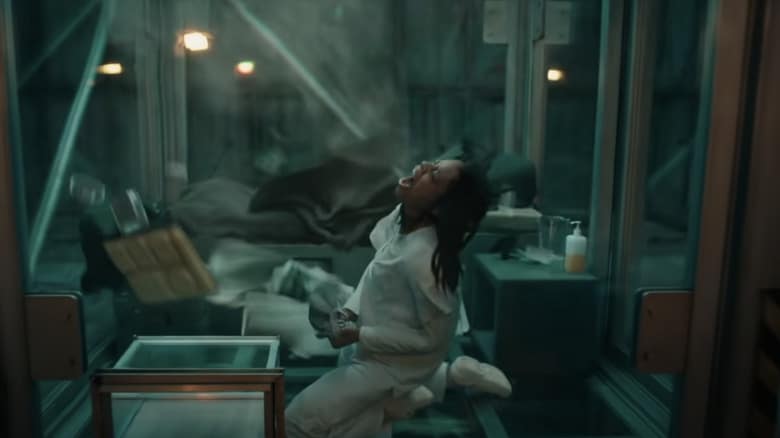
Serkis’ excellence in motion-capture directing and performance also allows him to do a much better job of framing scenes so that the symbiotes seem more lifelike, and like they’re actually present with the human characters. The first Venom didn’t seem to fully grasp how to portray the symbiotes’ movements especially in a believable fashion, so it kept feeling like the effects were too unbelievable, and the aliens weren’t actually there. Serkis mercifully fixes this problem, making both Venom and Carnage feel like actual characters that are truly present during this sequel’s various key sequences, and not just CGI junk layered onto scenes with reckless abandon.
This is a testament to Serkis knowing what to tweak, and what to leave alone. It’s also a testament to Serkis wisely just having fun with the production, tightening what he needs to, and otherwise not overthinking things. Serkis knows that Venom: Let There Be Carnage can’t possibly compete with the MCU (it also helps that Serkis has himself appeared in the MCU, playing popular Black Panther villain, Klaw), so he instead focuses on helming a sequel that fully leans into the most simple-minded demands of its audience. I don’t mean this as an insult either. It’s the right move for a Sony-made sequel to a Marvel-licensed movie that succeeded most when it actually wasn’t trying to make its titular character seem cool or edgy.
Marco Beltrami, an experienced genre composer with an extensive background in both action and horror, takes over the soundtrack of Venom: Let There Be Carnage, following Ludwig Goransson’s composing work on the original movie. Beltrami is an expert at faux-dramatic, popcorn-friendly scores, having worked on the satirical Scream movies, as well as several early video game-adapted movies like Max Payne and Resident Evil. Naturally, that’s exactly the kind of score that a movie like Venom: Let There Be Carnage demands. Much like anything else in this sequel, Beltrami’s score feels like a playful, yet bombastic backdrop that perfectly suits so much silly action and eccentric character banter. There’s nothing much to read into with this soundtrack, but that certainly fits with the rest of the production, so who’s going to be fussed about that?

The rest of the audio design in Venom: Let There Be Carnage is naturally just as over-the-top as anything else. Well, as much as this movie’s PG-13 rating allows it to get away with anyway. At least in this case, Venom: Let There Be Carnage doesn’t feel like it was initially designed with an R-rating in mind, only to be later watered down for a PG-13, like the first Venom clearly was. This allows it to deliver a more consistently unnerving, but not quite squeamish audio suite in the action scenes, leaning more into explosive, hard-hitting style than a more gross, lifelike sense of violence. Even Shriek’s sonic screams feel like they’re designed more to blast things around than to scare or disturb people, creating a surprisingly audience-friendly production that’s nonetheless still joyous fun for even the most hardened of Marvel fans to listen to.
Venom: Let There Be Carnage, in a bit of a rare move for studio tentpole sequels, carries virtually the exact same budget as its predecessor. This means that there is essentially no change to the level of visual fidelity present in this sequel, for better or for worse. Even so, the special effects in Venom: Let There Be Carnage remain pretty solid overall, if still noticeably beneath what the MCU often delivers. Venom’s effects have been cleaned up a bit here most notably, allowing the the character to feel a little more tangible and present than he sometimes did as the unstable mass of tar-like goo that he was in the first movie. This can likely be chalked up to Andy Serkis’ skilled visual direction, which adds much more life and believability to the symbiotes.
The action is also much cleaner and easier to follow in this movie compared to the first Venom. There’s definitely more of a focus on cartoon-ish zaniness in this sequel, but it’s still nice that the effects manage to work as more than a mess of ill-defined CGI in this case. This is why it’s too bad that the villain designs in Venom: Let There Be Carnage are kind of weak by comparison. Naomie Harris’ Shriek looks almost nothing like her comic book inspiration for starters (at least beyond her iconic blue eye scar), which isn’t really a huge deal, though her sonic effects are kind of unimpressive at times, and that’s a bigger deal. Sometimes they look pretty good, but at other times, Shriek feels like a disappointingly unimposing villain, lacking the mighty presence that she had in Marvel Comics, or even that old 16-bit Maximum Carnage video game from the 90’s!
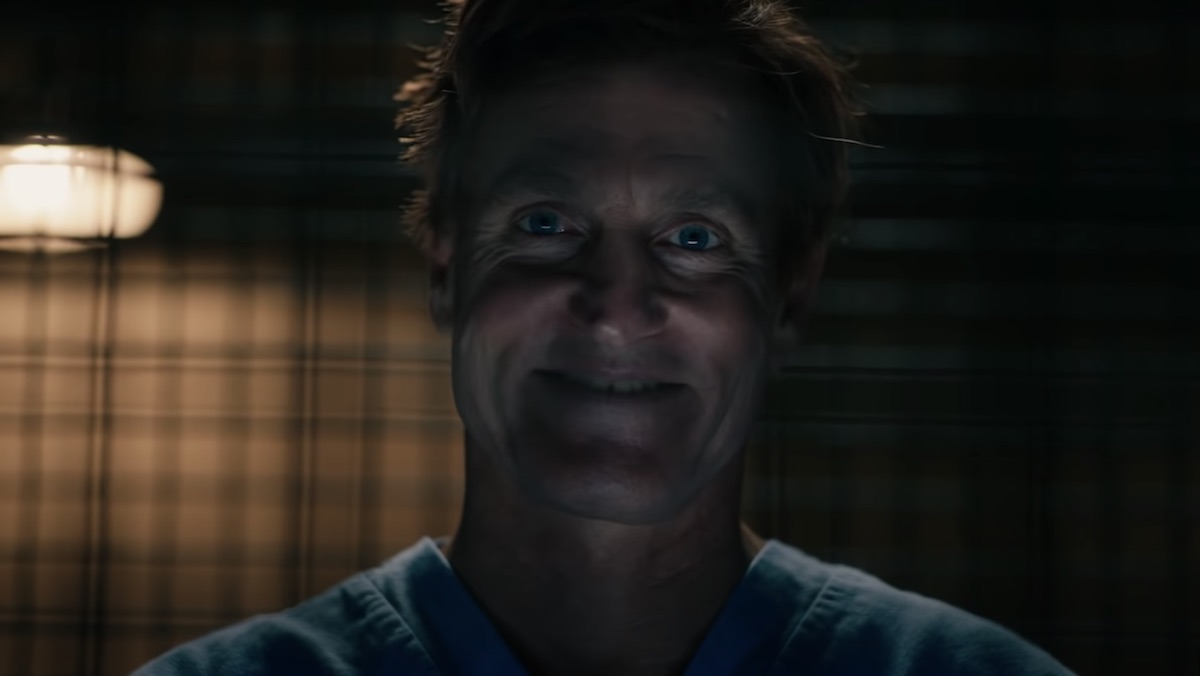
Woody Harrelson’s Carnage meanwhile is a bit of a mixed visual bag himself. The character’s grotesque transformations look fantastic, as do his violent combat flourishes, which manage to push this sequel’s PG-13 rating well enough to avoid the feeling of Carnage being ‘nerfed’ as a villain. Even then though, the design of Carnage himself is a little disappointing. His familiar red hue is dulled and not that striking, likely because Carnage’s blood-inspired motif has to be toned down significantly in this PG-13 movie, to avoid frightening younger viewers. That actually is one unfortunate concession to a live-action Carnage that there’s just no avoiding without an R-rating. Even so, the battles between Venom and Carnage at least look good here, with the overwhelming malleability of the Carnage symbiote being very well-realized. It’s just too bad that this infamously violent, sadistic Marvel character can only be so imposing without an R-rating to fully unleash his potential.
Venom: Let There Be Carnage is all killer and no filler, even if it means sacrificing any honest chance to be compared to the prestige superhero blockbusters of the MCU. Even so, this Sony-made Marvel sequel somehow manages to benefit from embracing its own inherent stupidity, re-branding the Venom movie franchise as a goofy, alien possession-themed comedy that’s no longer burdened by the need to be cool or scary, or even to take itself at all seriously. This is legitimately impressive when you consider that this sequel’s villain is an unrepentant, insane serial killer that murders almost anyone on sight, and has an equally lethal blood symbiote irrevocably bonded to his DNA.
Despite its complete lack of depth or brains however, Venom: Let There Be Carnage is still overall better than its 2018 predecessor, if also still hopelessly beneath what the MCU usually delivers. It’s a ridiculous, action-packed, surprisingly hilarious romp, one that’s still wholly devoid of the brilliantly grotesque depth and intelligence throughout Marvel’s Venom comic books, but somehow manages to be a lot of fun anyway, as long as you don’t mind that the Venom movie franchise is still stubbornly pressing on with a PG-13 rating.
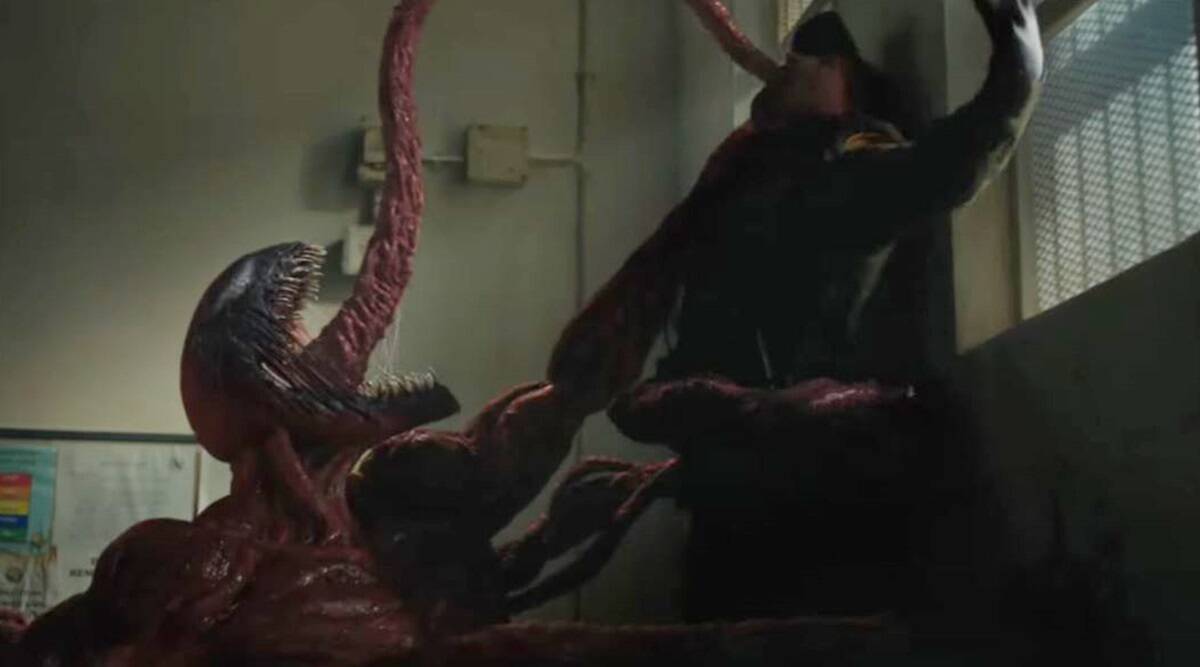
No matter how you slice it, Venom: Let There Be Carnage is a bad Marvel movie, especially considering how shallow and ill-plotted it is, but as a superhero B-movie on its own merits, one that will give willing audiences a truly laugh-out-loud escape for 90 minutes, it still succeeds in its own perverse way. Perhaps Sony’s Spider-Man Universe has found its niche then; Repeated selections of faux-angsty anti-hero cheese that openly mocks the cosmic joke of its own unlikely existence in an MCU-dominated world.
Excelsior?

